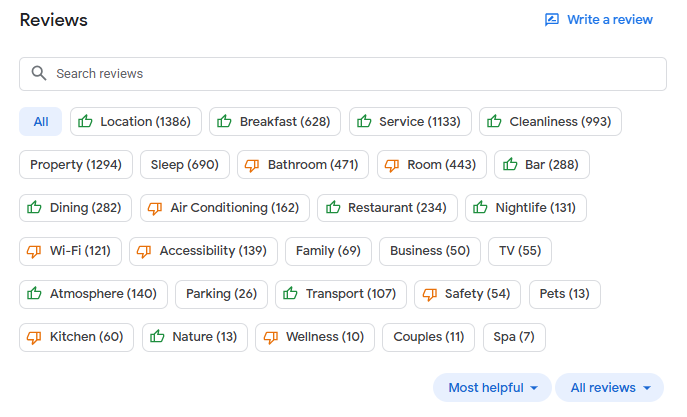Developing A Review & Brand Strategy Across 10 Or 100s Google Business Profiles via @sejournal, @TaylorDanRW
Managing reviews for dozens or hundreds of locations? Here’s how to protect your brand and keep customers from bouncing before they walk in. The post Developing A Review & Brand Strategy Across 10 Or 100s Google Business Profiles appeared...

Google Business Profiles (GBPs) have become essential for local search visibility, customer confidence, and driving foot traffic, especially for businesses with dozens or hundreds of physical locations.
Each profile acts as a digital brand touchpoint that directly influences how your business ranks in local searches and how your brand is perceived by potential customers.
However, managing reviews and reputation at this scale is no easy task.
When you oversee hundreds of profiles spread across different regions or countries, staying consistent becomes a real challenge.
Some locations might shine with great reviews and active responses, while others remain outdated or inactive, dragging down not just the individual store performance, but also the brand’s overall image.
This article explains how to build a scalable, practical strategy for managing reviews and brand presence across all your Google Business Profiles.
These insights come from real-world experience working with multi-location brands, some with thousands of listings, and from analyzing large-scale data using our tool, Mirador.
The Impact Of Reviews At Scale
Reviews are key in driving local search performance and validating and trusting your audience.
Google looks at them to assess trustworthiness, relevance, and authority in the map pack. Multi-location businesses directly influence how visible each listing is.
The effects of reviews reach far beyond “local SEO performance.” Reviews are often the first impression a customer gets.
A strong average rating, regular review activity, and thoughtful responses can quickly build trust.
If negative or old reviews remain unanswered or build up in high frequency over a short (and recent) period, you’ll likely lose potential new customers before they interact with your brand, products, or services.
At scale, trends begin to matter more. Google evaluates overall review frequency, recurring keywords, and how engaged the business is in replying.
 Screenshot from Google Business Profile Reviews, April 2025
Screenshot from Google Business Profile Reviews, April 2025
Profiles that stay updated and show ongoing customer interaction perform better.
So, a review strategy can’t just be about fixing problems store by store; it needs to support growth and visibility across your entire footprint.
Establish Your Baseline
Before any strategy can be effectively planned, you need to understand your current position and performance.
Begin by cataloging every active Google Business Profile, checking for duplicates, missing claims, or inaccurate details.
You then want to pull data on each listing’s performance:
How many reviews does it have? What’s the average score? Are the reviews recent? Is anyone responding to them?In many cases, you’ll find some locations are engaged while others have zero responses and haven’t been touched in months.
You can find this data through individual Google Business Profiles, aggregate via the API, or use a third-party tool.
 Screenshot from Google Business Profiles, April 2025
Screenshot from Google Business Profiles, April 2025
This audit becomes your foundation.
It identifies the most significant gaps and provides a way to measure progress over time.
Connect Review Management To Brand Identity
Reviews aren’t just feedback; they’re a public-facing extension of your brand. How you respond or don’t respond sends a message about your values and ability to consistently deliver a satisfactory experience.
If you promise friendly, fast service, that should come across clearly when you thank someone for a positive review or respond to a concern.
Your messaging should reinforce the key reasons customers choose your brand, whether it’s convenience, value, quality, or something else.
When appropriate, use reviews as an opportunity to share relevant information. If someone praises a new feature or product, thank them and mention that it’s available at other locations. This is a low-effort way to promote helpful information while staying on brand.
Also, think about how to repurpose strong reviews. Use them in ads, on your website, or inside stores.
A genuine quote from a customer often has more impact than any branded message, and this content is usually highly valued and desired by the broader marketing and sales teams.
This way, they can become a natural part of your brand story, told by customers and reinforced by how your business responds.
Create Brand Guidelines That Keep Things Consistent
Consistency becomes key in reviews when you need to respond to dozens or hundreds of locations.
Customers expect a thoughtful, helpful reply no matter which store they visit. Brand guidelines make that possible without turning every response into a very obvious, robotic copy-and-paste.
This is also a good opportunity to work with broader teams, including customer support departments if the brand you’re working with has one, to create a number of situation appropriate.
While defining your brand tone is important, review replies also need to show empathy.
If you respond to a negative review with an overly upbeat and jovial tone, you run the risk of deepening the negative experience that the user is already having.
Build templates for favorable reviews, neutral feedback, and complaints. Templates are just a starting point. They should give structure while leaving space for personalization based on the customer’s words.
Don’t share private info or respond defensively. Include clear steps for escalating sensitive reviews to the right people, whether customer service or regional leadership.
It’s also important to delegate who is responsible for replying. Some businesses centralize review responses, and others train local managers. Both approaches can work if the team has the training and tools to do it right.
Boost Review Volume Without Burning Out Teams
Keeping a steady stream of fresh reviews helps your rankings and reputation.
Recent positive reviews signal to Google and people that your business is active and trusted. The trick is building a reliable process that encourages reviews without demanding nonstop manual effort.
You want to find natural touchpoints to ask for reviews.
This could be right after a purchase, during a service visit, or following a support interaction. Use tools like email follow-ups, SMS reminders, or simple handouts with QR codes to make it easy for customers to leave feedback.
Where possible, automate it. Many customer relationship management (CRM) or point of sale (POS) systems can automatically trigger review requests post-transaction.
You want to ensure the message is polite, brief, and follows Google’s guidelines. Avoid incentives or ask only satisfied customers, since that can backfire or even lead to review removal.
Remove any friction from the process. Give customers a direct link to the correct location’s review page. Don’t expect them to search for you themselves. Look into tools that manage these links in bulk across all your profiles for significant operations.
A kind in-person reminder from someone who provided excellent service can go a long way, so it’s important that the staff working in the physical locations are pulling in the same direction.
Multiply that across all your stores, and the review volume adds up quickly.
Use Reviews As A Window Into The Business
Beyond search rankings and trust-building, reviews are a rich source of insight as they offer real-time feedback on what customers are experiencing.
When you look across hundreds of profiles, patterns begin to stand out, and it is important they are communicated to all necessary stakeholders, both the positive and the negative.
Share these insights regularly. Regional managers, store leaders, and marketing teams should all stay informed.
Use summaries or reports to spotlight what customers say most often, both good and bad. This helps everyone stay aligned and customer-focused.
You also want to group reviews by recurring themes and keep a quantitative log of how often these recurring themes are mentioned, ensuring the positive themes increase and the negative ones don’t.
If people mention cleanliness, service speed, friendliness, or product selection negatively, this could be a sign of failings in other departments.
If the same issue appears at multiple locations, it may present a more considerable operational challenge.
On the flip side, praise for specific staff or services can highlight what’s working well and should be replicated elsewhere.
Keep Improving
Review management isn’t something you set and forget. It requires a clear structure and consistent oversight to be effective.
It’s important to assign ownership, whether to an individual or a dedicated team, who can take responsibility for tracking performance, refining playbooks, and supporting store-level teams as needed.
Regularly reviewing key metrics like response rates, review frequency, and average ratings will help you stay on top of performance.
These insights can guide improvements, highlight areas that need attention, and allow you to make proactive changes before small issues turn into larger problems.
Final Thoughts
Managing reviews across a wide network of Google Business Profiles can seem daunting at first, but with a solid, scalable plan in place, it quickly becomes one of the most effective ways to earn trust, boost visibility in search, and reinforce your brand.
Begin by getting a clear view of your current review landscape, then put consistent systems in place for responding to, requesting, and learning from customer feedback.
Each interaction, review, and response plays a role in shaping the broader story of your business.
When reviews are managed thoughtfully, they become more than just customer opinions. They’re a key part of your growth strategy, helping you engage with customers, spot what’s working, and build a brand people believe in, one location at a time.
More Resources:
Do Reviews Still Matter? Study Looks At Changing Consumer Behavior New Study Finds That Review Requests Should Be Treated Like Customer Service A Guide To Local SEOFeatured Image: GamePixel/Shutterstock

 BigThink
BigThink 



















![The 2026 AI Search Benchmark Every SEO Leader Needs [Webinar] via @sejournal, @lorenbaker](https://www.searchenginejournal.com/wp-content/uploads/2025/11/1-259.png)












